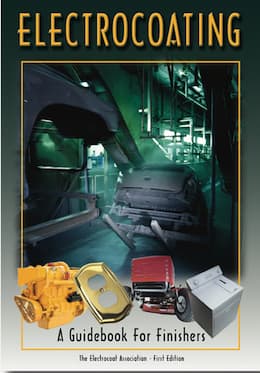
Curated with aloha by
Ted Mooney, P.E. RET

The authoritative public forum
for Metal Finishing 1989-2025

-----
Autophoretic Coating vs. E-Coating (CED)
Q. We currently use a 5/8" OD welded tube that has been E-coated black. Our process requires the ends of the tube to be expanded radially about 30%. As a result of this expansion the E-coat cracks and flakes about 5% of the time. Would an Autophoretic® coating improve this situation?
Craig Woodard- Brentwood, Tennessee, USA
A. Craig,
It may be prudent to check your pretreatment type and process. You should be able to reverse impact a pretreated and coated coupon of the same steel material; apply duct tape to the raised section, with no loss of E-coat paint adhesion when the duct tape is pulled. If you cannot pass this test, you may have a pretreatment problem.
Herb Ashley- Smartt, Tennessee
A. I would expect an 800 series Autophoretic® coating to perform significantly better in this application because of the nature of the process and the better T-bend performance of A-coat.
David Kalb- Bloomfield Hills, Michigan
A. Dear Craig,
Please be advised that we have supplied ACC 866 in Europe for use on parts where a deformation after painting is part of the process. Particularly on some rubber-metal parts. ACC 866 will meet a 0T bend test. It is definitely more deformable than the CED coatings I have tested.
Andy Thomas- Milton Keynes, UK
A. Craig,
As mentioned by others, it is likely Autophoretic® will give you better performance in this area.
Good luck!
Greg Wicklund- Madison Hts, Michigan
Autophoretic® Coating is a chemically applied corrosion coating in that everywhere it wets the steel substrate you get even film coverage. A tubular application is an excellent example of one of the advantages A-Coat has over an electrostatic coating process which has throwing power limits to coat the entire inside surface depending, of course, on the geometry.
Karen Ellerman- Elk Grove, Illinois
by Electrocoat Association

on eBay or
AbeBooks
or Amazon
(affil links)
![]() Thanks Karen. Your excellent point does seem to apply to e-coating of the I.D. of tubes. But as a semantic clarification, I think we're talking about electrocoating (electropainting, cathodic electrodeposition) -- and that you meant "electrocoating" rather than "electrostatic coating".
Thanks Karen. Your excellent point does seem to apply to e-coating of the I.D. of tubes. But as a semantic clarification, I think we're talking about electrocoating (electropainting, cathodic electrodeposition) -- and that you meant "electrocoating" rather than "electrostatic coating".
Regards,

Ted Mooney, P.E.
Striving to live Aloha
finishing.com - Pine Beach, New Jersey
Comparison between autophoretic and CED Coat
Q. Can you please send me Technical as well as commercial comparison between CED Coating and Autophoretic?
Shripad KulkarniPaint Shop - Nashik, Maharashtra, India
December 7, 2010
A. Cost comparison factors
1- Autophoretic 866 curing temperature 95-104 (Reduced energy cost)
2- No need for phosphating (Reduced waste treatment and chemical cost)
3- No need for Electrical power, only direct chemical reaction (Reduced power, maintenance cost)
4- typical 7 stage process
Quality performance
5- Up to 1000 hours salt spray test
6- 0T bend
7- Covers all immersed area to be coated (direct chemical reaction )

Hi Khaled. Thanks for the insights on the advantages of autophoretic coating.
I'm not trying to give anyone a hard time, but finishing.com's mission is to build a trusted technical reference for metal finishing, and I have to wonder if we're offering Shripad a well balanced analysis when this page covers a long list of advantages to a-coating, and a big fat zero in favor of e-coating. Considering that hundreds of shops choose to install e-coating instead, surely there must be at least some small features in its favor :-)
Regards,

Ted Mooney, P.E.
Striving to live Aloha
finishing.com - Pine Beach, New Jersey
July 2, 2011
A. Hello
It will be much more accurate when you apply the comparison parameters in your actual case,
Comparison Parameters like:
- Price/Kg
- Price/Litre
- Wt. solids as supplied
- Vol. Solids as supplied %
- price for 100% Vol. Solids
- Dry film thickness. (Microns)
- Theor. cov. vol. solids/m2
- Process Efficiency * as %.
- Coverage m2 after Efficiency
- Paint costs per m2
- Pretreatment/cleaning costs per 2
- Additives
- Net Plant Cost
- 2 processed per year
- Capital repayment (Amort. 5 year)
- Annual interest repayment (@10%)
- Total annual plant costs
- Plant costs 2
- Electricity costs/2
- Stoving schedule 20 Minutes.
- Effect. temp rise. (Amb. =20 °C)
- Oven heating costs per 2
- Afterburner costs per 2
- Maintenance per year
- Maintenance per 2
- Touch up manpower/yr
- Touch up manpower/2
Total cost per m2

Q. Dear Team,
Please let me know what is difference between Autophoretic coating & CED coating?
Regards,
Raju shelke
- Pune, India
October 11, 2012
October 11, 2012
A. Hi Raju.
Autophoretic coating has sort of a spring-loaded chemistry that reacts with the metal, causing chemical changes in the coating materials in the tank that result in deposition of the coating onto the substrate. CED is an acronym for cathodic electrodeposition, i.e., electrocoating wherein the work is cathodic. In CED coating, electricity causes those chemical changes that result in deposition onto the substrate. The two processes are thus quite similar, but with with one drawing its power from the inherent chemistry and the other having external power applied.
The comparison is rather analogous to autocatalytic electroless plating vs. electrolytic plating.
Regards,

Ted Mooney, P.E.
Striving to live Aloha
finishing.com - Pine Beach, New Jersey
Autophoretic vs. CED for truck chassis
Q. What kind of coating would you recommend on truck chassis. The material used being H.R.C.A. steel.
Farhad Khatao- Mumbai, India
Q. We are looking out for a cost effective coating process for replacing the existing AED process for truck frames (max frame size - 12 m long , cap- 100,000 frames / annum). Autophoretic process is being considered as a likely replacement. Could anybody help us with the following info :
a) Details of autophoretic installations processing truck frames and the experience with respect to cost & quality.
b) Maximum size of frames being processed
c) Any other alternative process for frame painting being processed with autophoretic critical issues to be considered while opting for the above.
Subhas Mallik- Pune, Maharashtra, India
2000
A. Each process has its own advantages and disadvantages. The performance specifications of the coating on one hand and the costing on the other will help you decide which bath to dip into.
adv.
Please contact me for more information.
Mohali, Punjab, India
2000
A. We have lot of experience in engineering coating plants for large structures (up to 24 m) a.o. truck frames. Processes used are:
Pretreatment: blasting, Fe or Zn phosphate, electrodip paint, autophoretic coating.
Coatings: liquid as well as powder. Largest automotive parts presently coated with ACC I know of is Land Rover plant in Turkey. Parts up to approx. 6 m in length. In our region actually several plants are coating truck frames. Capacity up to 25 pieces/shift.
Best regards

Remmelt Bosklopper
- Enschede, The Netherlands
A. The autophoretic process is a special process marketed by a major chemical company. The equipment for the autophoretic process can be manufactured by companies approved by that chemical company.
Electrocoating is another means of coating truck and auto frames. In the USA the method used by most of the frame manufacturing companies is electrocoat. The equipment for this process can be manufactured by many companies.
In some speciality shops the preferred method of painting truck and car frames is powder coating. Equipment for powder coating is also available from many companies.
Tyrone L. Caley- Jefferson City, Missouri
2000
March 4, 2009
A. Commercial aspects:
I'm sure that ACC866 meets the automotive industry Quality performance; on other hand it reduces the total coating cost.
You can simply contact Henkel to receive cost comparison.
Technically, frame coating process is divided into pre cleaning which depends up on the surface condition, the ACC Coating, rinse then reaction rinse, and curing; the process could be summarized as follows:
1- Spray Rinse (if the surface is highly rusted)
2- Dip Alkaline Cleaning
3- Tap Rinse
4- Pickling (if the surface requires)
5- Tap Rinse
6- Neutralization (in case you are using Acid Pickling)
7- Tap Rinse
8- Spray Rinse
9- D.I Rinse
10- ACC Coating
11- Tap Rinse
12- Reaction Rinse
13- Oven ( Curing )
Kindly note that the surface condition strongly affects the Number of Stages,
where if your work package contains corrosion Fe+++ you will need Acid pickling which in turn will require a rinsing and neutralization then Rinse again, whereas if your surface needn't have Pickling, you are going to reduce 4 Stage.
On other hand you may upgrade your current plant to use ACC

Q. Autophoretic vs. Electrophoretic vs. CED. We are working on the proposal of putting up a plant for Auto components (sheet metal parts) painting. Want to decide on the process. Will someone suggest for the best option, & the deciding parameters / comparison between the three. Also finish is important, being an auto component
BahubaliProduct Designer - Pune, Maharashtra, India
2007
2007
A. Hello, Bahubali. There are hundreds of Autophoretic installations and hundreds of electrophoretic installations. Neither set is a grand mistake caused by ignorant people not realizing that the other technology was better :-)
Rather, you need to study which is better for you, starting with the needs of the specific product. My understanding is that Autophoretic coating is corrosion resistant but is usually black and is usually not considered a decorative finish at the present state of the art. CED, which means "cathodic electrodeposition", is a type of electrophoretic deposition wherein the work is cathodic. It is more popular today than anodic electrophoretic deposition. Both processes are good for coverage of hard to reach areas, but CED lacquering can also be a highly decorative final finish. So I think a large issue for you will be whether the sheet metal auto parts you'll be working on are intended to be decorative.

Ted Mooney, P.E.
Striving to live Aloha
finishing.com - Pine Beach, New Jersey
Q. Dear Ted,
It will be a great help, as a expert in this field, if you can suggest me some study material which may provide in-depth knowledge which can also be helpful while negotiating with the supplier & also for regular use of the plant.
Bahubali
- Pune, Maharashtra, India
2007
2007
![]() Hi Bahubali. Although I spent my whole career in metal finishing, it would be a huge exaggeration to call me an expert in autophoretic vs. e-coating since I've never even seen an autophoretic installation first hand :-)
Hi Bahubali. Although I spent my whole career in metal finishing, it would be a huge exaggeration to call me an expert in autophoretic vs. e-coating since I've never even seen an autophoretic installation first hand :-)
A. There are probably technical articles and book chapters about these technologies, I am not familiar offhand with the reference material that you seek. You could start with Henkel for info on the autophoretic coating process, and with PPG, or other suppliers for info on the CED process. Best of luck.

Ted Mooney, P.E.
Striving to live Aloha
finishing.com - Pine Beach, New Jersey
Q. Is there any near future to autophoretic process in India when most of the automobile giants are referencing only CED process?
Arun Prasad Gnanasekaranpowder coating - Chennai, Tamilnadu, India
August 17, 2013
Q, A, or Comment on THIS thread -or- Start a NEW Thread